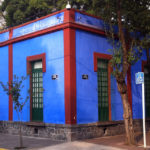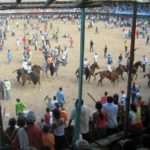It still seemed like the middle of the night when we exited the plane and started walking on the tarmac. A UN security guide was leading us into the US Army base located at the airport. The base is called Camp Sather (see here for more details) and has been in place since the invasion started in 2003. While walking towards the base installations, we could see BIAP about 1 kilometer away to our right. It looked just like any other modern international airport. No signs of war or destruction there.
The wind was still blowing quite hard but now it was much colder than when we left Amman. That same wind toyed with the light airplane while landing. The plane was swinging wildly from left to right and back while descending into Baghdad. Some travel peers thought we would probably miss the landing target and we would have to try over an a over again. But that never happened, fortunately.
UNAMI (the UN Assistance Mission for Iraq) shares with others a one-room office at the base. We headed there after collecting our luggage and PPE (Personal Protective Equipment which includes a military helmet and a bulletproof vest which, by the way, we will have to carry with us from herein on while in Iraq).

It was well after 5am after we finished doing all this. We were informed that we should have breakfast at the DFAC and then came back by 6:30am to catch the US Army helicopter that would bring us to Baghdad sometime after 7am.
I had no idea what DFAC meant and started right away to guess what it could mean. Since I was really hungry, after having missed dinner, I followed the crowd which included colleagues that had been here many times before and knew the ropes. I was one of the two freshmen (or freshperson!) in a group of 14 people heading to Baghdad.
Security at the base is very tight. To access the DFAC (could the C stand for cafeteria?) everyone is required to show a valid ID, cleared by the US Army. I always assumed that my blue UN ID, which at HQ we call Grounds Pass, was sort of global and would open any doors. I showed my ID to the US DFAC officer. He promptly acknowledged that he had never seen such an ID. He demanded to see additional proof that I was indeed a UN staff member traveling legit into Iraq. This same routine took place every time I had to show my ID to some security officer in Iraq. The next time I head this way I will make sure I get a UNDP Iraq ID (as well as an MNFI –MultiNational Force – Iraq– one). Fortunately, one of the UNDP colleagues had brought a letter that corroborated my affiliation and travel purpose. I was cleared to go in and finally feed myself.
The DFAC (could the F be for food?) is a large storehouse with no partitions whatsoever. The food and the servers are located against the walls and most of the stuff which is self-service is right in the middle. While entering, signs indicated that washing hands is mandatory. The DFAC (could D stand for Department? Hmm, I’m getting closer…I think) is a typical US cafeteria in terms of both decoration and food. It could be located in any US city. Crossing the entrance doors is like crossing a space (not time) machine, almost…
At the DFAC (what could that damn A mean?) I was impressed by a few things. First and foremost, the age of US soldiers. Most of them are pretty young, early twenties I would guess. I was a bit shocked by this as I was expecting something else, not sure what though. I also noticed that there are plenty of women soldiers, also very young. And most of them come to the DFAC with their weapons. I know nothing about weapons so I cannot identify them. They looked like very powerful and large rifles or semi-automatic weapons. And they looked heavy to me too. Having breakfast in a room full of weapons in the hands of young people did not reassure me a lot. On the other hand, as we were on a military base, I could not expect otherwise.
My hunger managed to take control of the situation and I went for scrambled eggs, hush potatoes and bacon -stuff I hardly ever eat. I also found some jalapeños and found Tabasco sauce at the tables. Bread and strong coffee (so said the label on the coffee machine; but it turned out to be flavored coffee instead!) supplemented my first meal in 15 hours.
We left the DFAC (ok, Division for Food and Cafeterias!) half an hour later to make the time we had been suggested by UNAMI personnel. We picked up our bags and PPE and headed to the waiting area where the helicopter -or helo- was supposed to depart any time soon. And we started to wait and wait. About an hour later, we were informed that due to the weather conditions, especially the heavy winds, there would be no helicopter ride. Instead, we had to go for plan B. I was not aware of any plan B but I have heard about the infamous Rhino Armored Buses, the same ones used to move Saddam Hussein while he was on trial in Iraq.
So now the only way we could get to Baghdad was by Rhino. But I soon discovered that the Rhinos only run at night. So we have to wait until the evening to catch it. This will not happen before 10pm. It was 9am and by now we were all dead tired.
I decided to give up on DFAC and, instead of looking on the web, decided to ask one of my more experienced colleagues. “DFAC? That’s easy”, he said. “Dining FACility”. Using the free Wi-Fi connection at the base, I then searched in Google and found this: DFAC.
Little did I know then that I would be “DFACing” for the next 7 days or so…






Comments
One response to “Heading to Baghdad II: So close but yet so far”
Post Edited: Heading to Baghdad II: So close but yet so far https://t.co/LL6YMX4lik